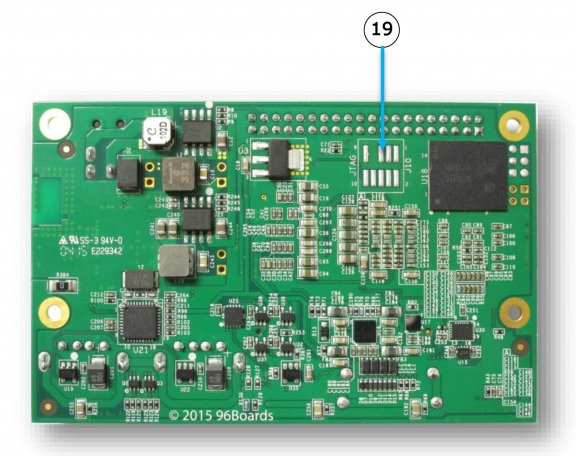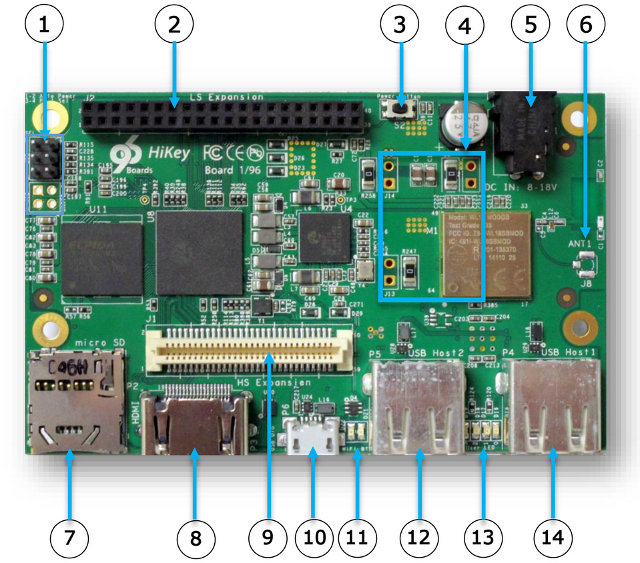In my post about the Embedded Linux Conference 2015, I noticed a talk entitled “Generalizing Android for Low-Cost 64-Bit ARM-Based Community Boards” to be presented by Khasim Syed Mohammed, Linaro, mentioning that “Linaro is developing an open hardware platform specification to encourage software development on low-cost boards to lower the cost and accelerate the availability of maker and embedded products based on ARM SoCs”. But at the time, I had no details about the specifications themselves. As Linaro Connect HK 2015 is now taking place, the 96Boards Consumer Edition specifications have been released, and Hikey board have been unveiled with HiSilicon Kirin 620 octa core Cortex A53 processor, 1 GB RAM, and 4GB eMMC.
Hikey board specifications:
- SoC – HiSilicon Kirin 620 octa core Cortex A53 processor @ 1.2 GHz (10,000 Dhrystone VAX MIPS) with ARM Mali-450MP4 GPU
- System Memory – 1GB LPDDR3 @ 800 MHz
- Storage – 4GB eMMC + micro SD v3 slot
- Video Output / Display – HDMI 1.3 up to 1080p, DSI interface
- Connectivity – 802.11 a/b/g/n Wi-Fi, Bluetooth 4.1 LE (TI Wilink 8 – WL1835MOD) with on-board antenna. Solder pads for external antenna are also present (6)
- USB – 2x USB 2.0 host ports, 1x micro USB OTG
- Camera – CSI interface
- Debugging – Unpopulated 4-pin UART header (1), unpopulated 10-pin JTAG header (19)
- Expansion headers
- 40-pin LS (Low Speed) Expansion connector (2) – 2x UART, 2x I2C, GPIOs, SPI, Audio, reset, 1.8V and GND, as wekk as 5V/12V cooling fan support
- HS (High Speed) Expansion connector (9) – DSI, CSI, SDIO, USB, etc…
- Misc – Power button (3), settings header for power/boot/user (1), power measurements through holes (Total / PMIC only / HDMI, USB) (4), LEDs for Wi-Fi/Bt (11), and 3x User LED (13)
- Power Supply (5) – 8-18V / 2A as per 96Boards specs.
- Dimensions – 85 x 54 mm
 Documentation is available on 96Boards.org, and currently includes a User’s Guide and schematics in PDF format. You can get support on 96Boards Forums, the source code is available on github, and binary images for Linux (Ubuntu?) and Android will soon be available at https://builds.96boards.org/.
Documentation is available on 96Boards.org, and currently includes a User’s Guide and schematics in PDF format. You can get support on 96Boards Forums, the source code is available on github, and binary images for Linux (Ubuntu?) and Android will soon be available at https://builds.96boards.org/.
Hikey board is available on backorder on Avnet and Arrow for $129 and up.
Let’s also have a quick look at 96Boards specifications.
Stated goals:
- Low cost ($50-$100 retail for a a minimum configuration)
- Easy to extend with off the shelf parts available to maker community and OEMs
- Easy to purchase globally (for example, via Amazon, Alibaba, Farnell, Digikey, Mouser, etc…)
- Enable a third party ecosystem to develop around expansion (mezzanine) boards/peripherals/displays, etc… that can be used on any 96Board CE compliant board.
Minimum hardware features:
- Ultra-small low-profile form factor – 85x54x12 mm – Extended Version: 85x100x12mm
- Design is SoC independent (targets 32- and 64-bit SoCs)
- 0.5GB RAM (Minimum 1GB recommended for Android_
- MicroSDHC Socket for up 64GB on-board or expansion flash storage
- Wi-Fi 802.11g/n and Bluetooth 4.0 LE
- On-board connectors and expansion I/O:
- 2x USB Type A or Type C host ports (USB 2.x or 3.x)
- USB micro-B USB or type C slave or OTG port (USB 2.x or USB 3.x) for PC connection
- Display and Audio Output: HDMI, or MHL (micro USB), or DisplayPort (USB type C)
- Low profile 40 way female header for maker/community use
- Low profile 60 way high speed female module header for advanced maker/OEM use with high speed interface including MIPI-DSI, USB, and optional MIPI CSI-2
- Board power from low profile DC jack connector
Other requirements and options include at least one current sense resistor, buttons, LEDs, UART, recommended JTAG, and so on.
Software requirements include bootloader (open source), accelerated graphics support (binary or open source), a Linux kernel buildable from source code based from mainline, or the latest Google-supported Android kernel version, or the last two LTS kernels, and one of more of the following operating systems: Android, Debian/Ubuntu, Fedora/Red Hat, or an OpenEmbedded/Yocto build of a Linux distribution.
[Update: Linaro blogged about this, with quotes by several companies including Actions Semiconductors and AMD, so we might expect 96Boards compliant board(s) by these two Silicon vendors too]
Via Mininodes.

Jean-Luc started CNX Software in 2010 as a part-time endeavor, before quitting his job as a software engineering manager, and starting to write daily news, and reviews full time later in 2011.
Support CNX Software! Donate via cryptocurrencies, become a Patron on Patreon, or purchase goods on Amazon or Aliexpress





